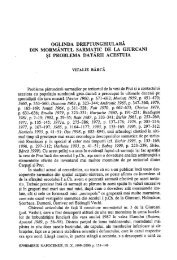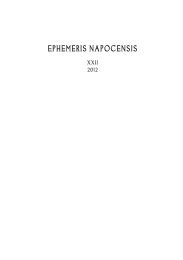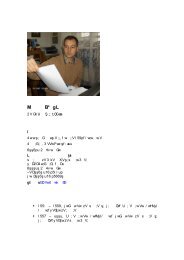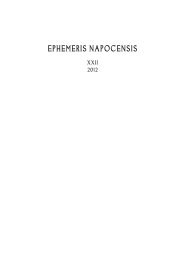EPHEMERIS NAPOCENSIS - Institutul de Arheologie Åi Istoria Artei
EPHEMERIS NAPOCENSIS - Institutul de Arheologie Åi Istoria Artei
EPHEMERIS NAPOCENSIS - Institutul de Arheologie Åi Istoria Artei
You also want an ePaper? Increase the reach of your titles
YUMPU automatically turns print PDFs into web optimized ePapers that Google loves.
Silvia Mustaţă, Sorin Cociş, Valentin Voişian<br />
INSTRUMENTUM BALNEI FROM ROMAN NAPOCA.<br />
TWO IRON VESSELS DISCOVERED ON THE SITE<br />
FROM VICTOR DELEU STREET *<br />
Silvia Mustaţă 1 , Sorin Cociş 2 , Valentin Voişian 3<br />
Abstract: The two iron toilette vessels analysed in this article were discovered in Cluj‐Napoca during<br />
the rescue excavations carried out on Victor Deleu Street between 1992 and 2001. Both of them correspond<br />
from a stratigraphic viewpoint to the second stone phase of the two buildings researched on the site<br />
which belonged to the resi<strong>de</strong>ntial area of the Roman town. Taking into account the context of discovery,<br />
they were <strong>de</strong>finitely in use in Napoca during the first three quarters of the 3 rd century AD. Due to<br />
the rarity of such objects at the scale of the Roman Empire, the analysis focuses on the technical aspects<br />
that the manufacturing process of such items implies (employing X-ray photography), on the parallels<br />
from the rest of the Roman world and on the possible prototypes which might have influenced the <strong>de</strong>velopment<br />
of such shapes in iron.<br />
Keywords: Napoca, iron vessels, instrumentum balnei, technology, prototypes<br />
During archaeological research carried out in Cluj‐Napoca, Victor Deleu Street, two<br />
iron vessels were discovered which will be the subject of the present article. The vessels are<br />
unique in Roman Dacia and represent remarkable finds at the level of the Roman Empire.<br />
The analysis will focus on the technical aspects that the objects imply as well as on parallels and<br />
possible prototypes.<br />
The site<br />
The archaeological rescue excavations un<strong>de</strong>rtaken more or less continuously in Cluj‐Napoca,<br />
Victor Deleu Street (Pl. I/1) between the years 1992 and 2001 revealed important information<br />
about the evolution of the ancient town of Napoca 4 . Besi<strong>de</strong>s the medieval and mo<strong>de</strong>rn habitation<br />
*<br />
A preliminary version of this paper was published in Instrumentum. Bulletin du Groupe <strong>de</strong> travail européen sur<br />
l’artisanat et les productions manufacturées dans l’Antiquité (see: MUSTAȚĂ ET ALII 2012). The authors would like<br />
to express their gratitu<strong>de</strong> towards dr. Cosmin Onofrei and resi<strong>de</strong>nt Dan Duma for their help in X-raying the objects<br />
and towards dr. Mariana Egri and Szilamér Péter Pánczél for the useful discussions referring to the prototypes.<br />
1<br />
“Babeş-Bolyai” University, Cluj‐Napoca, RO; e-mail: silvia_mustata@yahoo.com.<br />
2<br />
Institute of Archaeology and Art History Cluj‐Napoca, Romanian Aca<strong>de</strong>my Cluj Branch, M. Kogălniceanu<br />
str. 12–14, 400084, Cluj‐Napoca, Cluj county, RO; e-mail: scocis@yahoo.com.<br />
3<br />
National Museum of Transylvanian History, Constantin Daicoviciu str. 2, 400020, Cluj‐Napoca, RO;<br />
e-mail: vvoisian@yahoo.com.<br />
4<br />
For the preliminary excavation reports see: COCIŞ ET AL. 1995; COCIŞ ET AL. 1996; COCIŞ ET AL.<br />
1997; COCIŞ ET AL. 1998; COCIŞ ET AL. 1999; COCIŞ ET AL. 2002. See also: RUSU-BOLINDEŢ 2007,<br />
97–98; GĂZDAC ET AL. 2010, 7–8.<br />
Ephemeris Napocensis, XXII, 2012, p. 235–251















